Physical Address
304 North Cardinal St.
Dorchester Center, MA 02124
Fractures of the head of the radius are the most common fractures of the elbow. The majority occur between the ages of 20 and 60, with the incidence in females being twice that of males. Although fractures that are not displaced typically occur in isolation, displaced fractures are frequently associated with injuries of the medial and lateral collateral ligaments and/or of the interosseous membrane. In more severe injuries, dislocations of the elbow and forearm may be associated with fractures of the radial head. Fractures of the coronoid, olecranon, and capitellum are commonly seen in association with fractures of the radial head and further impair elbow stability. The radial head is an important stabilizer for the elbow in the setting of these associated bony and ligamentous injuries.
Although nondisplaced and minimally displaced fractures of the radial head usually have a favorable functional outcome with nonoperative management, there is little information guiding the optimal treatment of patients with displaced and/or comminuted fractures. In 1935 Jones stated: “Fracture of the head or neck of the radius with displacement is a serious injury. While the prognosis is good for recovery of a useful elbow, rarely is it a normal elbow.” This statement remains true today. A mechanical block to motion is an absolute indication for surgery. Concomitant injuries requiring surgical treatment, such as a large displaced coronoid fracture or elbow instability, frequently dictate the management of the radial head. Good results have been reported following open reduction and internal fixation for selected noncomminuted displaced radial head fractures. Excision of fragments, early or delayed radial head excision, and arthroplasty all have a role in the management of more comminuted displaced fractures.
A patient’s history usually indicates that there was a fall onto the outstretched hand. High-energy injuries, such as a motor vehicle crash, typically have more comminuted fracture patterns and a higher incidence of associated injuries. Inspection may reveal ecchymosis along the forearm and/or medial aspect of the elbow. Tenderness over the radial head is expected and typically the most notable anteriorly. Pain over the lateral epicondyle may represent a concomitant injury of the lateral collateral ligament. Careful palpation of the medial epicondyle and the sublime tubercle of the ulna should be performed to look for an associated medial collateral ligament injury. The interosseous membrane of the forearm and the distal radioulnar joint should be evaluated for tenderness; however, these injuries are often subtle and may not be evident even with a careful physical examination. Because associated injuries of the shoulder, forearm, wrist, and hand are common, these areas should also be examined. A careful neurologic and vascular examination of the extremity needs to be performed; however, concomitant nerve and arterial injuries are rare and usually associated with severe injuries.
Range of motion, including forearm rotation and elbow flexion-extension, should be evaluated. Palpable and auditory crepitus should be noted during movement. Forearm rotation is generally preserved (albeit painful) but may sometimes be limited by pain or a mechanical block. In these circumstances, reevaluation a few days later may be prudent. Alternatively, aspiration of the hemarthrosis and injection of local anesthetic should be considered. With a sterile technique and with the forearm in pronation to protect the radial nerve, a needle is introduced into the lateral soft spot located at the center of a triangle formed by the lateral epicondyle, olecranon, and radial head ( Fig. 19.1 ). After the hemarthrosis is aspirated, 10 mL of 1% lidocaine (Xylocaine) is injected. Persistent loss of rotation after pain relief suggests a mechanical block, whereas palpable grating suggests articular incongruity; both require surgical management. A mild loss of terminal elbow flexion and extension is expected as a consequence of an elbow hemarthrosis and does not necessarily indicate a mechanical block that needs surgical treatment.
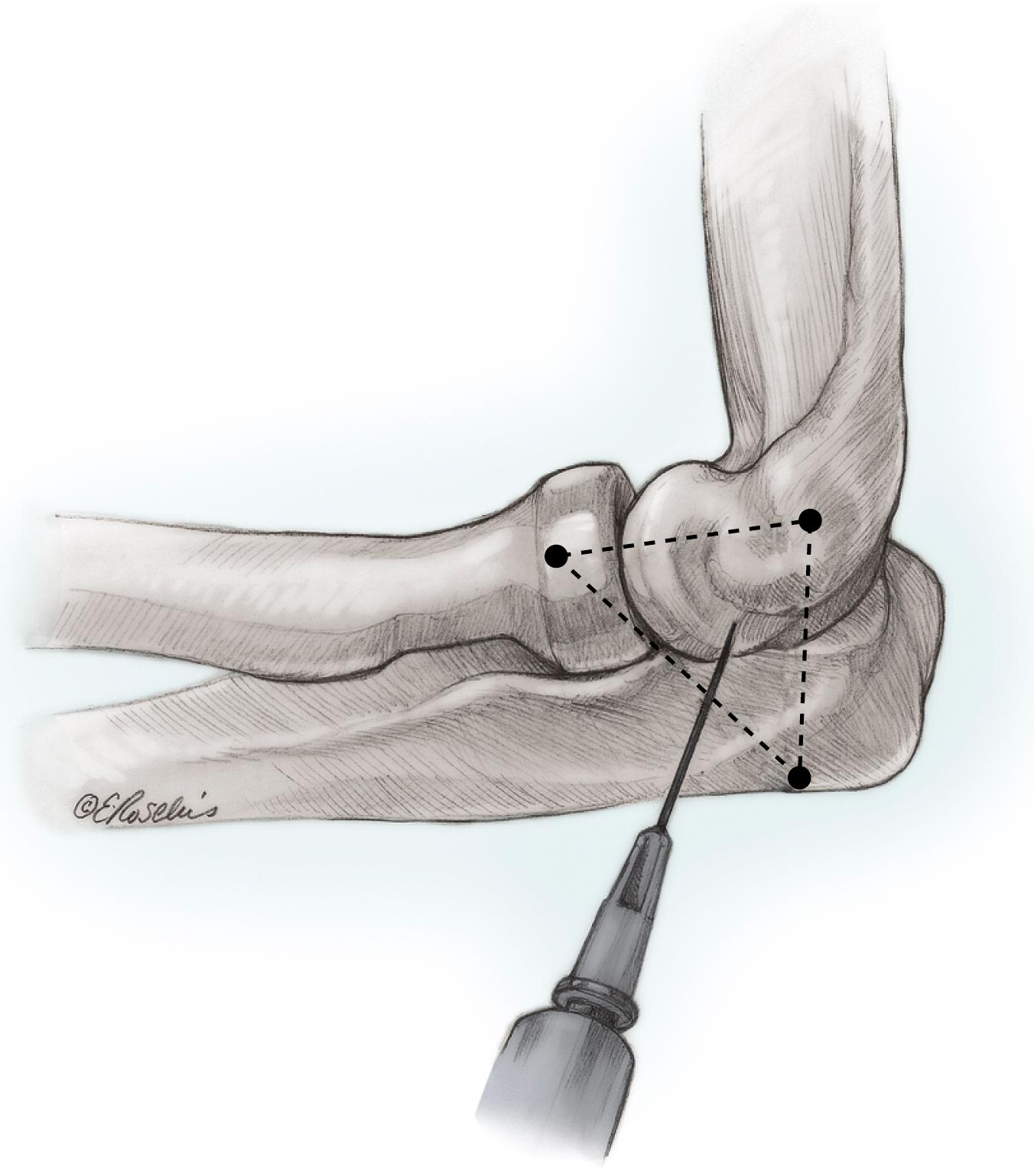
Anteroposterior, lateral, and oblique elbow radiographs usually provide sufficient information for the diagnosis and treatment of fractures of the head of the radius. The x-ray beam must be centered on the radiocapitellar joint to ensure a tangential view of the radial head. Because a hemarthrosis prevents elbow extension, two anteroposterior radiographs may be required if there is significant loss of extension: anteroposterior views of the distal humerus and the forearm. An oblique radiocapitellar view can be useful as it places the radial head in profile. The elbow is positioned for a lateral radiograph, but the x-ray tube is angled 45 degrees cephalad ( Fig. 19.2 ). In patients with nondisplaced fractures of the radial head or neck, plain radiographs may only demonstrate elevation of the anterior or posterior fat pads (sail sign) as a consequence of a hemarthrosis ( Fig. 19.3 ). Bilateral posteroanterior radiographs of both wrists in neutral rotation should be performed to evaluate ulnar variance in patients with wrist discomfort and in those who have a comminuted fracture of the radial head as there is a higher incidence of an associated interosseous membrane injury in these patients. Magnetic resonance imaging (MRI) or ultrasound studies may be considered to evaluate the presence of associated collateral ligament or interosseous membrane injuries, but these investigations are uncommonly required. , Because of the cylindrical shape of the radial head, conventional elbow radiographs often underestimate the extent of articular surface involvement and magnitude of displacement. , Computed tomography (CT) is useful to quantify fracture size, location, displacement, and comminution in cases in which the indications for surgery are less clear. CT may also assist with preoperative planning with respect to the need for specialized equipment for fracture fixation or prosthetic replacement.
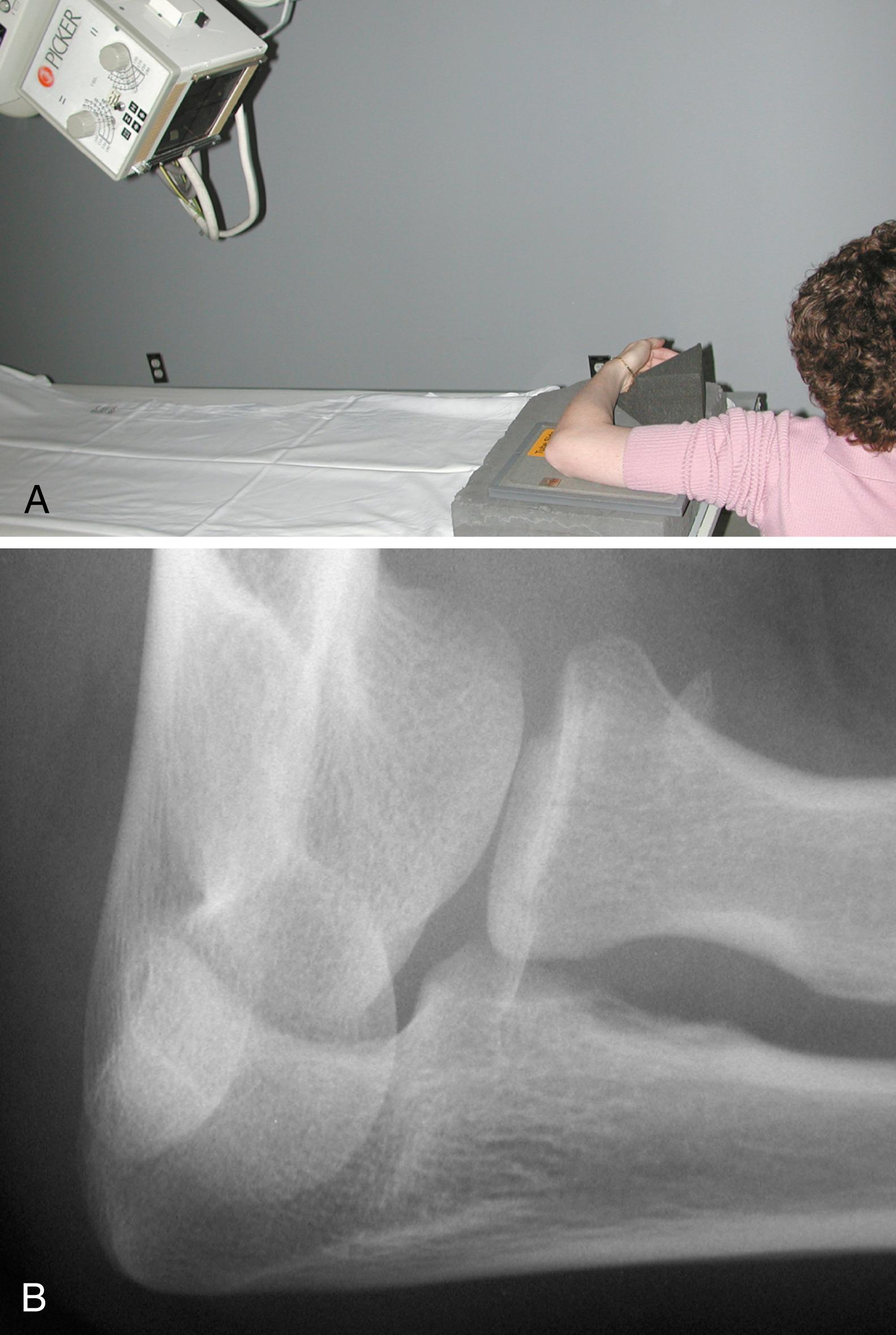

Mason classified fractures of the radial head into three types: type I, fissure or marginal sector fractures without displacement; type II, marginal sector fractures with displacement; and type III, comminuted fractures involving the whole head ( Fig. 19.4 ). One study demonstrated moderate to poor intraobserver and interobserver reproducibility of this classification based on plain radiographs. Other authors have reported that many Mason II fractures are reclassified to type III during surgery owing to additional fracture segments being found that are not revealed on plain radiographs. Johnston added a fourth type: fracture of the radial head associated with an elbow dislocation. This additional category does little to direct treatment other than to emphasize that radial head excision without replacement is contraindicated in the setting of an associated elbow dislocation. Morrey has suggested that isolated fractures of the radial head be referred to as “simple or uncomplicated,” while those associated with other soft tissue or bony injuries be referred to as “complex or complicated.”
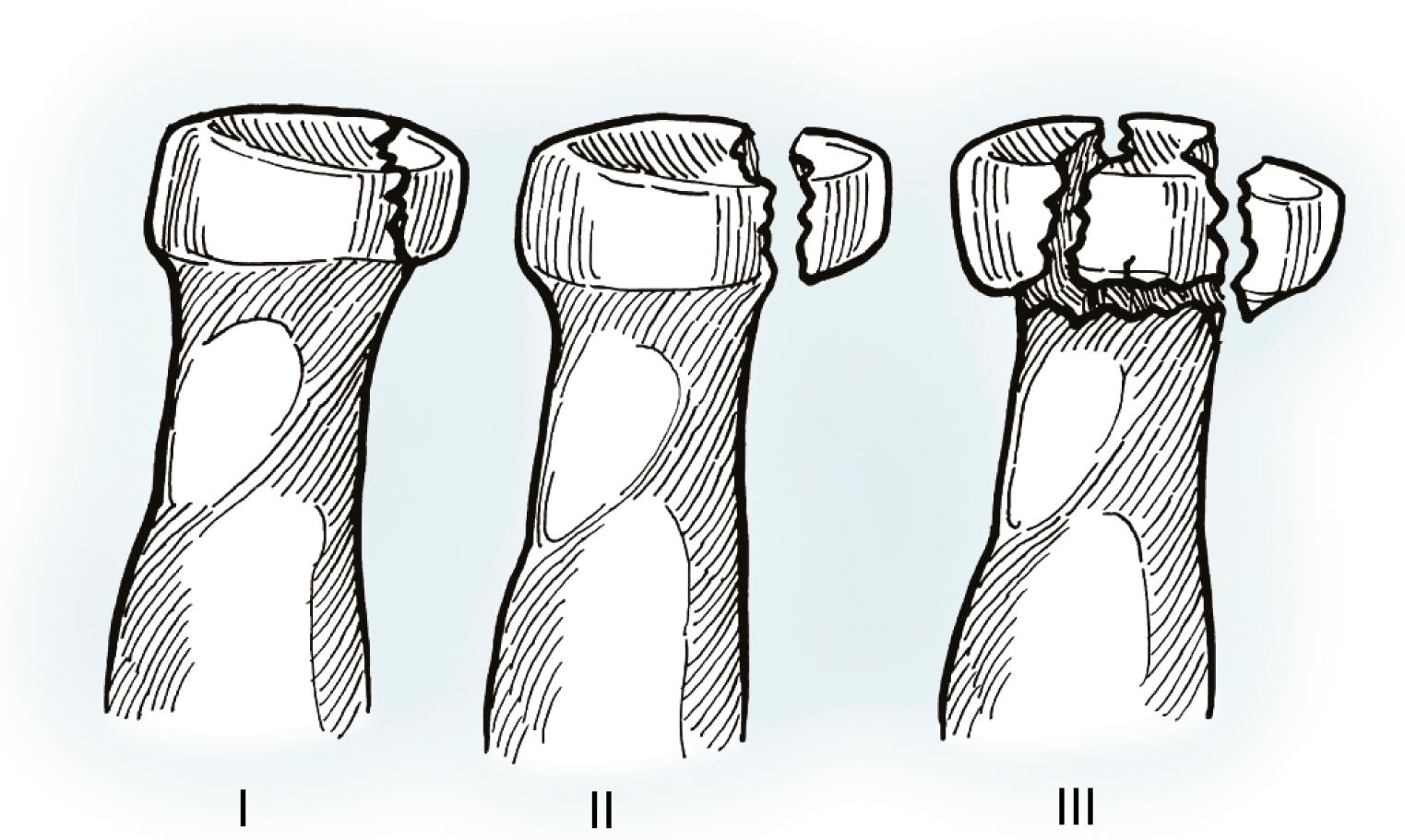
More recently, Hotchkiss developed a management-based classification with three types ( Table 19.1 ):
Type I: nondisplaced or minimally displaced (<2 mm) small marginal fracture of the head or neck with no mechanical block to motion
Type II: displaced (>2 mm) fracture of the head or neck that is reconstructible with open reduction and internal fixation (ORIF). It may have a mechanical block or be incongruous; more than a marginal lip fracture
Type III: comminuted fracture of the head or neck that is unreconstructible as judged by radiographs or at surgery; usually requires excision for movement
| Type I | Nondisplaced or minimally displaced fracture of head or neck |
| No mechanical block to rotation | |
| Displacement >2 mm or a marginal lip fracture | |
| Type II | Displaced (usually >2 mm) fracture of head or neck (angulated) |
| May have mechanical block to motion or be incongruous | |
| Without severe comminution (technically possible to repair using open reduction and internal fixation) | |
| More than a marginal lip fracture of the radial head | |
| Type III | Severely comminuted fracture of the radial head or neck |
| Judged not reconstructible on basis of radiographic or intraoperative appearance | |
| Usually requires excision for movement |
a All of these fractures may have associated injuries (e.g., a coronoid fracture, elbow dislocation, medial collateral or lateral collateral ligaments) or interosseous membrane tears.
While the Hotchkiss classification helps to direct treatment, the type of operation needed is less clear because the distinction between types II and III fractures remains problematic. The decision as to which fracture is reconstructible depends on surgeon factors (e.g., experience and implants available), patient factors (e.g., osteoporosis), and fracture factors (e.g., fragment size, comminution, and associated soft tissue injuries). The final decision as to whether a fracture is reconstructible or whether it requires radial head excision and/or replacement often can only be decided during surgery. Therefore this classification, to some extent, may be of more use retrospectively and is less helpful in deciding which type of surgery should be performed.
Fractures of the radial head and neck commonly occur following a fall on the outstretched hand. A comminuted fracture of the radial head or neck is likely the result of failure in compression due to axial or valgus loads ( Fig. 19.5 ). In one cadaveric study, an isolated fracture of the radial head was most likely to occur when an axial load between 35 and 80 degrees of flexion is applied. In 1924 Odelberg-Johnson reported that elbow subluxation was an important mechanism of wedge fractures in a series of cadaveric experiments. In the author’s experience, posterolateral rotatory subluxation of the elbow, the first stage of an elbow dislocation, likely causes many of these anterolateral wedge fractures. This segment of the radial head shears off as the rim of the radial head dish subluxates off of the capitellum with the forearm in neutral to supination.
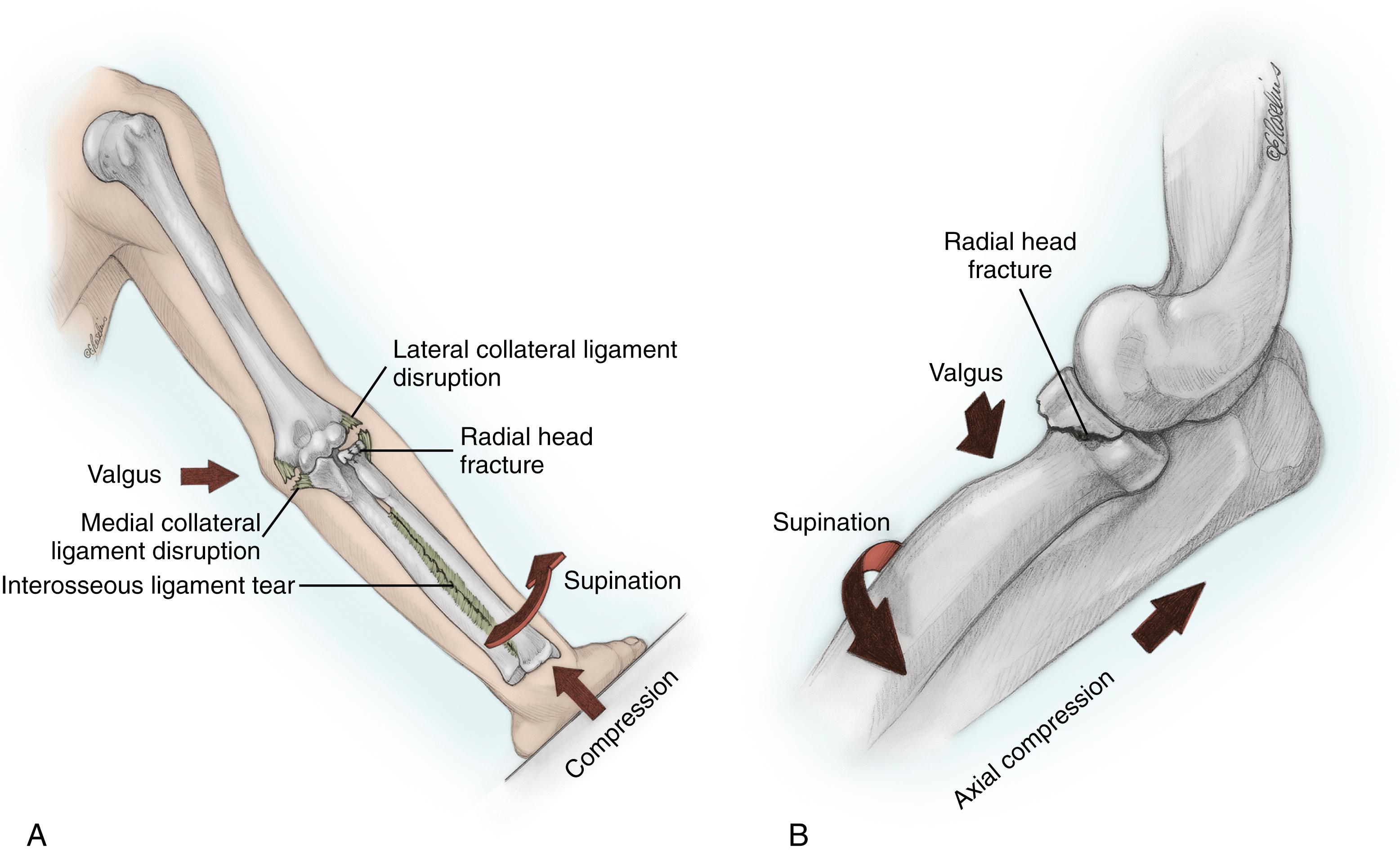
Displaced fractures of the radial head are commonly associated with disruption of the ligaments of the elbow or forearm. , , In one study, no patient with a minimally or nondisplaced fracture had an associated disruption of the medial collateral ligament when stress radiographs were performed. However, 71% of patients with a displaced shear fracture of the radial head or an impacted fracture of the radial neck had a medial collateral ligament injury. All of the patients with a comminuted fracture had disruption of the medial collateral ligament of the elbow or of the interosseous membrane of the forearm (91% and 9%, respectively).
Johansson, using arthrography, reported medial collateral ligament or capsular disruptions in 4%, 21%, and 85% of Mason types I, II, and III fractures, respectively. Itamura and colleagues performed MRI scans on 24 patients with displaced Mason types II and III fractures of the radial head. They reported that the medial collateral ligament was disrupted in 54%, the lateral collateral ligament was disrupted in 80%, both collateral ligaments were disrupted in 50%, capitellar osteochondral defects were present in 29%, capitellar bone bruises were evident in 96%, and loose bodies were noted in 92%. In one series of patients with Essex-Lopresti injuries presenting for reconstruction, 15 of 20 had undergone a radial head resection without knowledge of the forearm ligamentous injury, suggesting that this uncommon injury may be easily missed in clinical practice. Collectively, these data suggest that minimally displaced fractures have a low incidence of associated soft tissue disruption. More displaced and comminuted fractures are likely of higher energy and therefore have a greater incidence of associated ligamentous injuries. Careful physical examination and intraoperative evaluation of the elbow are needed to detect these associated ligamentous injuries.
Fractures of the capitellum may be appear as chondral injuries or displaced osteochondral fractures. Ward and Nunley reported that 50% of patients with fractures of the capitellum had an associated fracture of the radial head, whereas only 1% of the fractures of the radial head had a capitellar fracture. For displaced fractures of the radial head treated operatively, the incidence of an associated capitellar fracture was 24%. These injuries may or may not be visible with plain radiographs or CT scans and are often only diagnosed during surgery. Capitellar fractures may be responsible for a mechanical block of elbow or forearm motion in the absence of significant displacement of a fracture of the radial head seen radiographically ( Fig. 19.6 ). They may also be responsible for some of the late radiographic changes and symptoms seen in a subset of patients with these injuries.
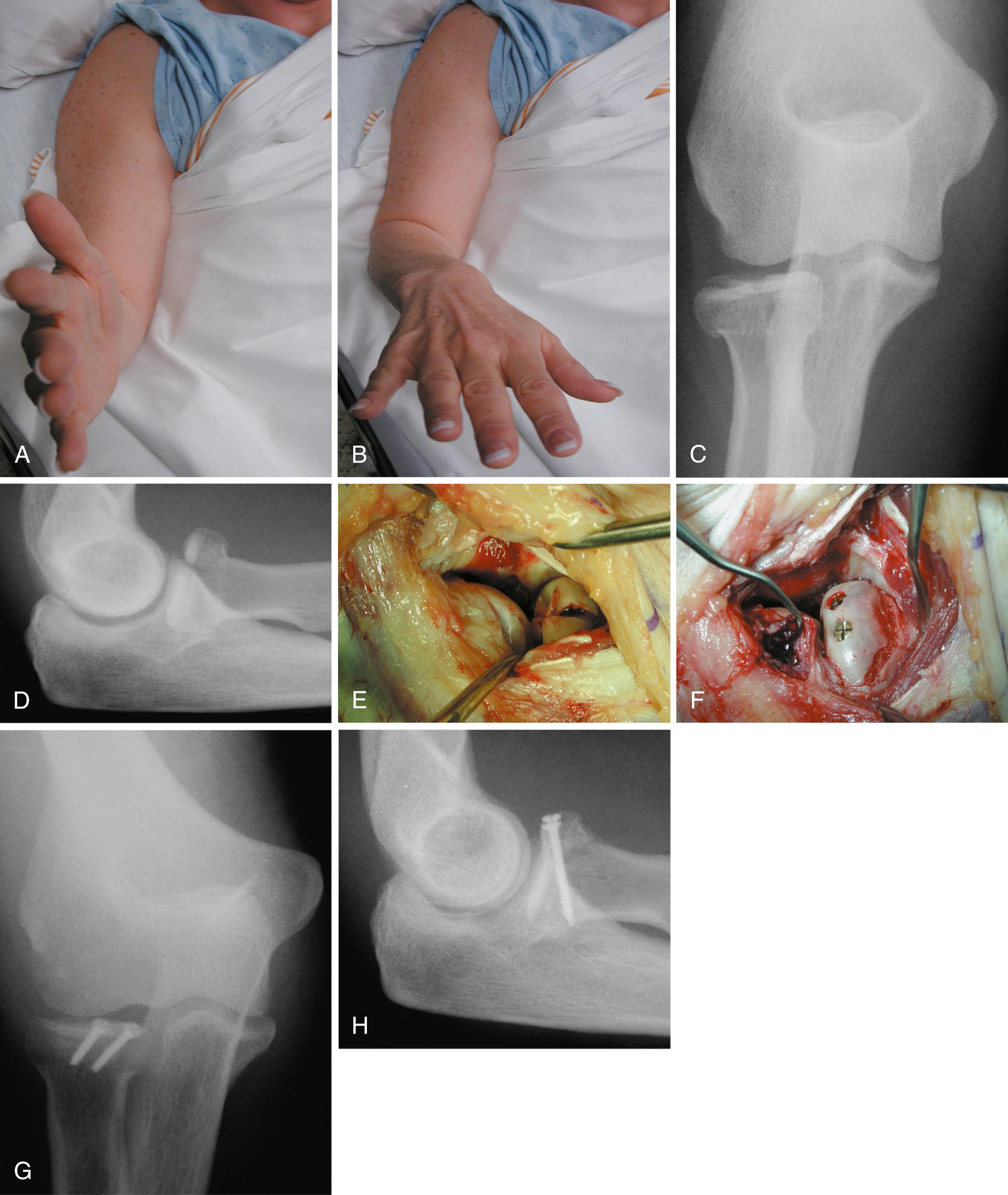
Dislocations of the elbow are seen in 3% to 10% of patients with fractures of the radial head. , , Patients with an associated elbow subluxation or dislocation may have a fracture of the coronoid as part of a “terrible triad” injury, with disruption of one or both collateral ligaments of the elbow. Small coronoid fragments typically present as triangular fragments situated anteriorly in the coronoid fossa and are often mistaken as a fragment of the radial head. Larger coronoid fragments are associated with greater instability of the elbow and require specific treatment as outlined in Chapter 22 . Elbow fracture-dislocations should be managed by immediate closed reduction followed by treatment of the radial head, the same as for isolated fractures. , , , Whereas some authors recommend urgent operative management of the radial head if needed (within 24 h) to reduce the incidence of heterotopic ossification, this practice remains controversial. , Early motion seems to improve outcome; therefore urgent, not emergent, management of the fracture is appropriate. While some authors suggest radial head excision in patients with an elbow dislocation can lead to acceptable long-term results, , most studies recommend against this due to a high risk of recurrent instability. , , Fractures of the olecranon or proximal ulna may also be seen in association with fractures of the radial head as a variant of the Monteggia fracture.
The anatomy of the radial head and neck is complex and highly variable. , The head of the radius consists of a circular concave dish that articulates with the spherical capitellum ( Fig. 19.7 ). The dish has a greater radius of curvature than the capitellum, making this articulation only moderately constrained. The articular dish is variably offset from the axis of the radial neck. The margin of the radial head that articulates with the radial notch of the ulna is slightly elliptical, producing a cam effect during forearm rotation that displaces the shaft somewhat radially during pronation. The radial notch of the proximal ulna comprises an arc of 60 to 70 degrees and forms a relatively congruous articulation with the radial head, allowing for only modest radioulnar translation during forearm rotation. The anterolateral one-third of the articular margin of the radial head is devoid of articular cartilage, allowing placement of internal fixation without impingement with the radial notch during forearm rotation.
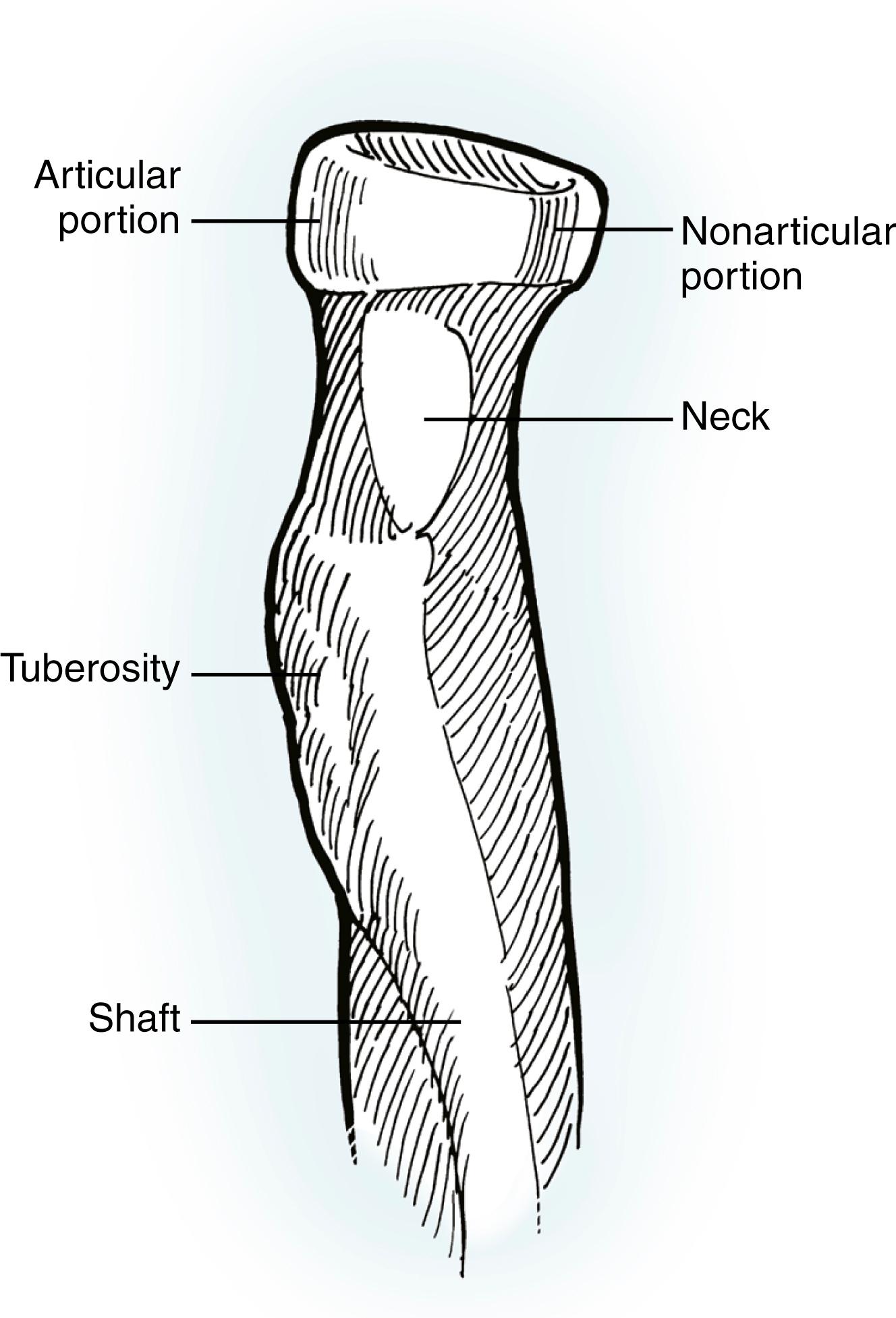
A “safe zone” for internal fixation has been described as a 110-degree arc centered on a point 10 degrees anterior to the midpoint of the lateral side of the radial head as judged with the forearm in neutral rotation ( Fig. 19.8 ). This nonarticular portion can also be identified by the rounded shape of its margin relative to the flatter surface that articulates with the proximal radioulnar joint. The rotational interval between the Lister tubercle and the radial styloid of the distal radius is another useful anatomic landmark for the nonarticular portion of the radial head. Placement of plates on the nonarticular margin may be required when managing fractures involving the radial neck. The radial head is surrounded by the annular ligament; therefore bulky internal fixation is poorly tolerated. Implants should be low profile to minimize soft tissue adherence that may impede forearm rotation.
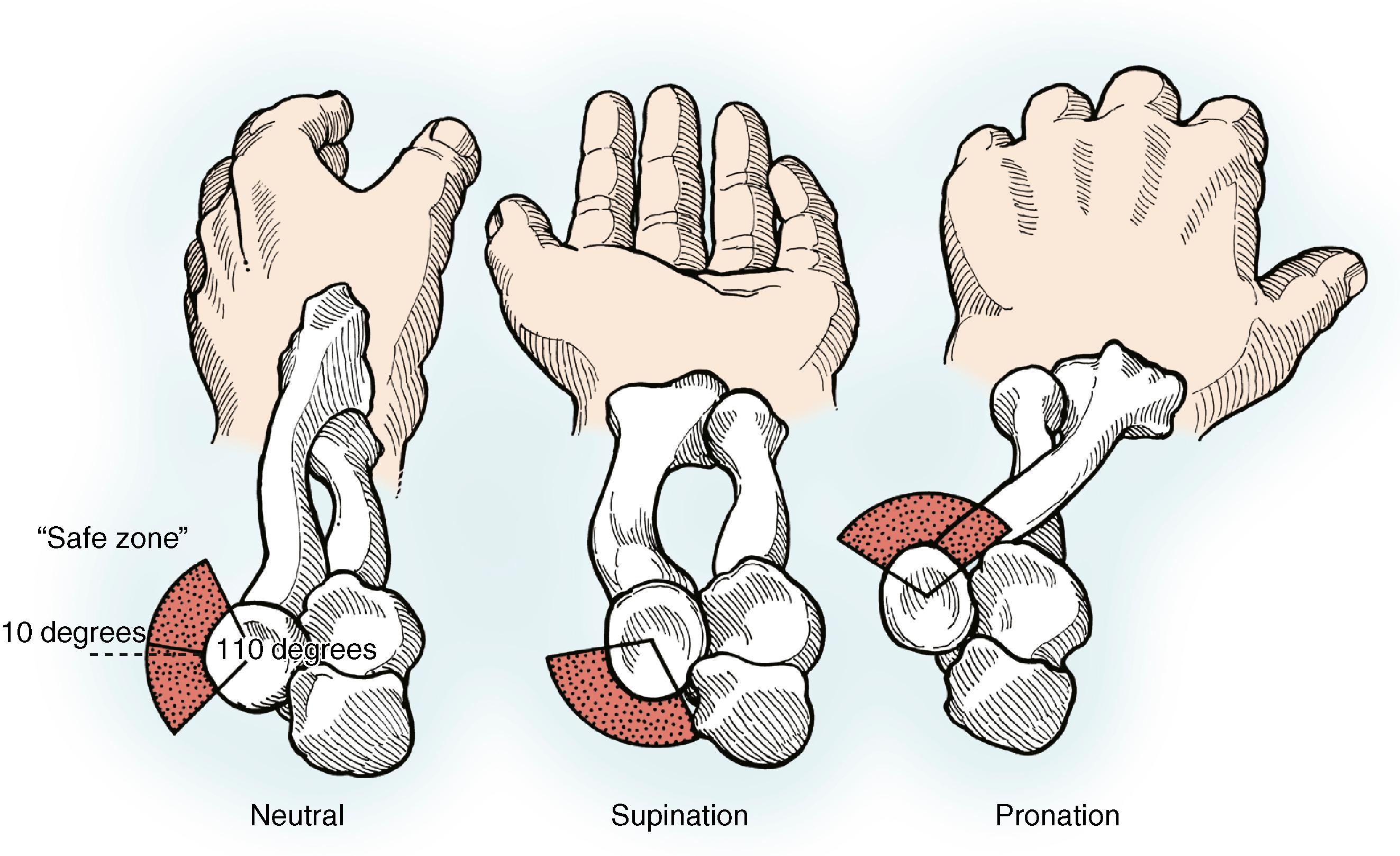
The cancellous trabeculae are oriented perpendicular to the surface of the radial head, confirming the load-bearing function of the radial head. It has been suggested that the subchondral bone is weaker in the anterolateral portion of the radial head; this was confirmed by a recent CT imaging study demonstrating that the cancellous bone volume was lowest in the anterolateral quadrant of the radial head.
The blood supply of the radial head is composed of both intraosseous and extraosseous sources. Vessels penetrate the radial neck from the periosteum at the head-neck junction; the dorsolateral periosteum is a key area for these branches. Preservation of the periosteal attachment of displaced fragments is important during ORIF of fractures of the radial head and neck. Proximal radius plate fixation further compromises the vascularity of the radial head.
A better understanding of the lateral ligamentous anatomy of the elbow has resulted in improvements in surgical techniques for fractures of the head of the radius. The annular ligament wraps around the radial head, attaching to the anterior and posterior margins of the radial notch of the ulna and stabilizes the radial head in the proximal radioulnar joint. The radial collateral ligament arises from the lateral epicondyle and attaches to the annular ligament. The lateral ulnar collateral ligament arises from the lateral epicondyle and inserts on the crista supinatoris of the proximal ulna. The lateral ulnar collateral and radial collateral ligaments are important restraints against varus and posterolateral rotational instability of the elbow ( Fig. 19.9 ).
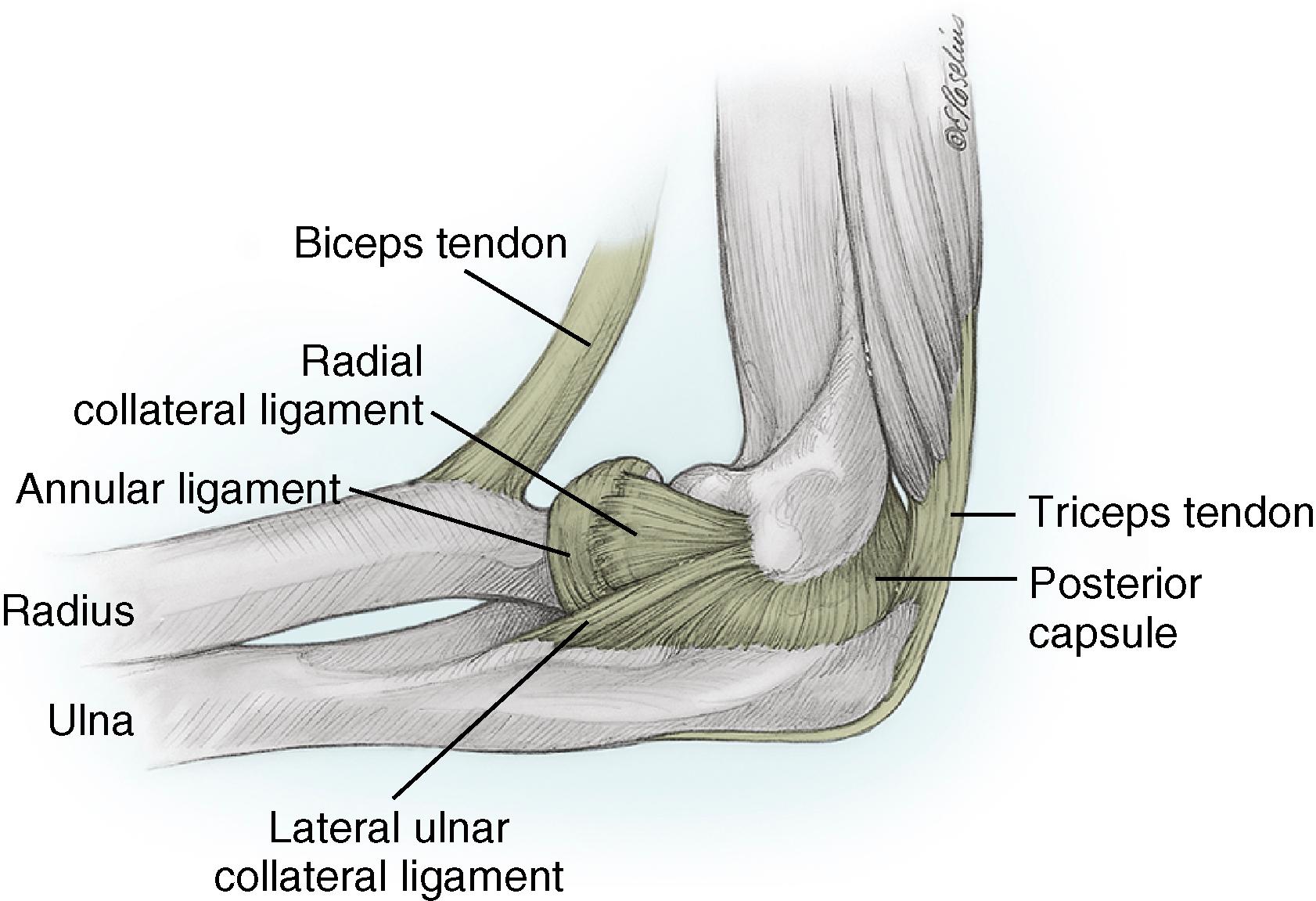
Conventional surgical approaches to the radial head through the Kocher interval (between the extensor carpi ulnaris and the anconeus) often cause iatrogenic injury to the lateral ulnar collateral ligament unless the dissection is brought more anterior such that the radial collateral and annular ligaments are divided at the midaxis of the radial head. Additionally, this approach tends to expose the radial head too posteriorly to permit internal fixation of the commonly involved anterolateral portion of the radial head. , Maintaining the integrity of the lateral ulnar collateral ligament or performing a strong repair to bone is essential to prevent instability, which may be an important cause of failure of internal fixation, late pain, and arthritis.
Repair of the fascial interval between the anconeus and extensor carpi ulnaris has also been shown to further augment elbow stability. For isolated fractures of the radial head without associated ligamentous or osseous injuries, a more anterior muscle-tendon splitting approach through the common extensor tendon at the midportion of the radial head should be considered. This approach allows for good visualization of the radial head and avoids detachment of the lateral ulnar collateral ligament. However, it is less extensile distally, limited by the proximity of the posterior interosseous nerve, which lies on average 33 mm (minimum 22 mm) from the capitellum in supination and 52 mm (minimum 38 mm) in pronation.
Resisted isometric elbow flexion has been estimated to generate forces up to four times body weight across the joint. , The radiocapitellar articulation may account for up to 60% of the load transfer across the elbow. Contact forces across this articulation are greatest with the forearm in pronation. Displaced fractures of the radial head result in a decreased residual surface area available for load transfer and therefore increased cartilage contact pressures, which may predispose to arthritis. Excision of the radial head increases the tension in the medial collateral ligament and concentrates the forces acting across the elbow on the lateral aspect of the ulnohumeral joint; it has been calculated that the force can reach as high as nine times body weight. Posterolateral rotational instability of the elbow is aggravated by excision of fragments or the entire radial head as a consequence of both the loss of “capture” of the articulating dish of the radial head by the capitellum and a diminished tensioning effect on the lateral collateral ligament. , Repair or replacement of displaced radial head fractures improves load transfer and elbow stability. ,
The head of the radius is an important valgus stabilizer of the elbow, particularly in the setting of an incompetent medial collateral ligament. In vitro biomechanical studies have shown that the kinematics and stability of the elbow are altered by radial head excision, even in the setting of intact collateral ligaments. , Replacement of the radial head with metallic prostheses has been demonstrated to improve the stability of elbows with intact and deficient medial and/or lateral collateral ligaments. , Axial forearm stability is also improved by metallic radial head prostheses in the setting of an interosseous ligament disruption. Silicone radial head replacements are inferior to metallic implants for restoring both axial and valgus stability. ,
Paul of Aegina (CE 625–690) was likely the first to report an injury to the proximal radius, as documented by Schwartz and Young in an excellent review of the early history of radial head fractures. Desault, in 1811, suggested that fractures of the proximal radius were uncommon relative to the middle or distal end and that diagnosis was difficult because of the surrounding thick muscular covering. In 1897, Helserich described a fracture of the radial head and suggested that resection of it was helpful for late deformity. In 1910, Hammond stressed the utility of radiology in making the diagnosis of a fracture of the radial head, which he noted to be difficult based on patient history and physical examination alone. He also found that marked fracture displacement was a poor prognostic sign for outcome with nonoperative management and recommended excision of the fragments or radial head. In 1926, Cutler described three types of fractures of the radial head and recommended closed treatment for fractures that were not displaced. He recommended surgery if a displaced fragment interfered with full motion or prevented reduction of an elbow dislocation and also in cases of malunion, ankylosis, or forearm stiffness.
Watson-Jones reported in 1930 that only a 50% good result could be obtained in the management of displaced fractures of the radial head. He avoided excision of it as a result of the “inevitable” radial shortening with subluxation or dislocation of the lower end of the ulna. Angulated fractures of the radial neck were stabilized with a sling of kangaroo tendon because he felt that angulation interfered with forearm rotation. In 1935, Jones reported that good results could be achieved by excising fragments that involve less than one-third of the radial head. He reported better results with early-versus-late radial head excision.
In 1950 Carstam reported that generally fractures of the radial head were not isolated injuries; most had an elbow subluxation that had spontaneously reduced. He suggested that ORIF should be considered for marginal fractures with moderate displacement and reported good outcomes. The results of fragment and whole-head excision were not appreciably different. He noted changes, such as cubitus valgus and proximal migration of the radius, were frequent but did not commonly cause symptoms, except in children.
In 1954 Mason reviewed 100 patients who had sustained a fracture of the radial head and described a classification system. He recommended nonoperative treatment for nondisplaced type I fractures and reported good results. Type II fractures, which he described as “marginal sector fractures with displacement,” had more variable results. He recommended that conservative treatment should be pursued if the fracture fragment did not involve more than one-quarter of the articular circumference and was reasonably well aligned. In all other cases, “no matter how minimal the tilting and comminution of the fracture segment,” he recommended excision of the radial head. He described the axiom of radial head fracture treatment as follows: “If in doubt—resect.” Type III fractures were comminuted, and he advised primary radial head excision and reported good early results. In 1962 Johnston added a fourth subtype to the Mason classification: a radial head fracture associated with an elbow dislocation. He considered that radial head excision was not a benign procedure and stated: “If in doubt, treat conservatively.”
Subsequent to these papers, there has been an explosion of interest in radial head anatomy, , , , biomechanics, , , , , , , , , and fracture management. The importance of the radial head to the kinematics and load transfer of the elbow is now better understood, and there is an increasing interest in salvaging the radial head whenever possible. , , , Advances in screw-and-plate designs have resulted in increasing utilization of ORIF for displaced fractures of the radial head with excellent results for simple fracture configurations, but in larger series the complication rates remain high, with failure more common in patients with a concomitant elbow dislocation. Even though long-term follow-up studies suggest that radial head excision is generally well tolerated clinically in the absence of associated ligament injuries, the incidence of osteoarthritis has been high. , , , , Implant arthroplasty has become popular for the treatment of comminuted displaced fractures of the radial head where ORIF is not possible or less predictable.
Speed reported the use of a metallic radial head arthroplasty in 1941. Subsequently, acrylic was employed with some early success. Silicone implants gained widespread use in the 1970s and early 1980s. , More recently, there has been a resurgence of interest in metallic radial head implant arthroplasty as a result of problems with wear and failure of silicone when placed under compressive load. , , The success of first-generation metallic radial head implants has led to newer modular designs to allow easier implantation and improved sizing options to provide a closer match to patients’ anatomy. , ,
Fractures of the head of the radius should be managed based on patient factors such as age, bone quality, associated injuries, and activity level. Fracture factors that influence decision making include size, displacement and location, and the presence of a mechanical block to elbow or forearm motion. For example, an older patient with osteoporosis and a comminuted fracture of the radial head is a poor candidate for internal fixation. Arthroplasty of the radial head is the preferred option for displaced unreconstructible fractures in the setting of an associated injury to the medial or lateral collateral ligaments or the interosseous membrane because excision further compromises instability. , , ,
The influence of radial head fracture size and displacement on patient outcome is unknown due to a lack of scientific data directing clinical practice. In vitro biomechanical studies reveal a progressive loss in radiocapitellar joint stability with increasing size of wedge defects in the radial head. , Wedge defects greater than one-third of the radial head do not contribute to stability in this model. These data suggest that, particularly in the setting of elbow instability, fixation of fragments smaller than one-third of the radial head may be advantageous. Whereas it seems that most displaced intraarticular fractures in other joints benefit from anatomic reduction, stable fixation, and early motion, displaced fractures of the radial head historically have often been managed nonoperatively if they do not impede joint motion.
Good long-term clinical results have been reported in the majority of patients with the nonoperative treatment of isolated displaced partial articular fractures of the proximal radius. , Greater articular displacement causes abnormal joint contact pressures and is associated with poorer functional outcomes and may predispose to the development of arthritis or persistent pain at either early or late follow-up. While delayed excision of the radial head is typically helpful under these circumstances, complete relief of symptoms is not assured. , , Randomized clinical trials are needed to compare the outcomes of operative and nonoperative treatment of displaced radial head fractures without a block to motion or associated injuries requiring treatment. Fractures with a mechanical block to motion have a clear indication for surgical treatment regardless of their size. These are typically fractures that involve the articular portion of the radius or fragments that extrude into the proximal radioulnar joint.
The degree of displacement of a fracture of the neck of the radius that requires surgery in adults is unknown; a mechanical block to rotation remains the primary indication for surgical management. Although most nondisplaced fractures of the radial neck heal when treated with early motion, nonunions do occur. , , Nonoperative treatment is recommended except in the setting of associated injuries requiring surgical management such as fractures of the coronoid process or olecranon. Translation of the radial head on the neck produces a cam effect and often impedes forearm rotation if it is greater than 2 to 3 mm. Neck angulation of more than 20 degrees in adults commonly interferes with forearm rotation as a result of altered kinematics with the capitellum and radial notch of the ulna and should be considered for surgical management.
The initial management of a fracture of the radial head associated with an elbow dislocation is a gentle closed reduction of the elbow under intravenous conscious sedation. Repeat radiographs taken after the reduction should be obtained to better evaluate the radial head fracture for further management, either nonoperative or operative. A careful assessment for an associated fracture of the coronoid and/or capitellum is needed for patients with a fracture of the radial head, particularly those with a history of an elbow dislocation. The presence of a coronoid fracture suggests an unstable elbow for which operative management may be required to achieve an optimal outcome. The author’s recommended management is the algorithm shown in Fig. 19.10 .
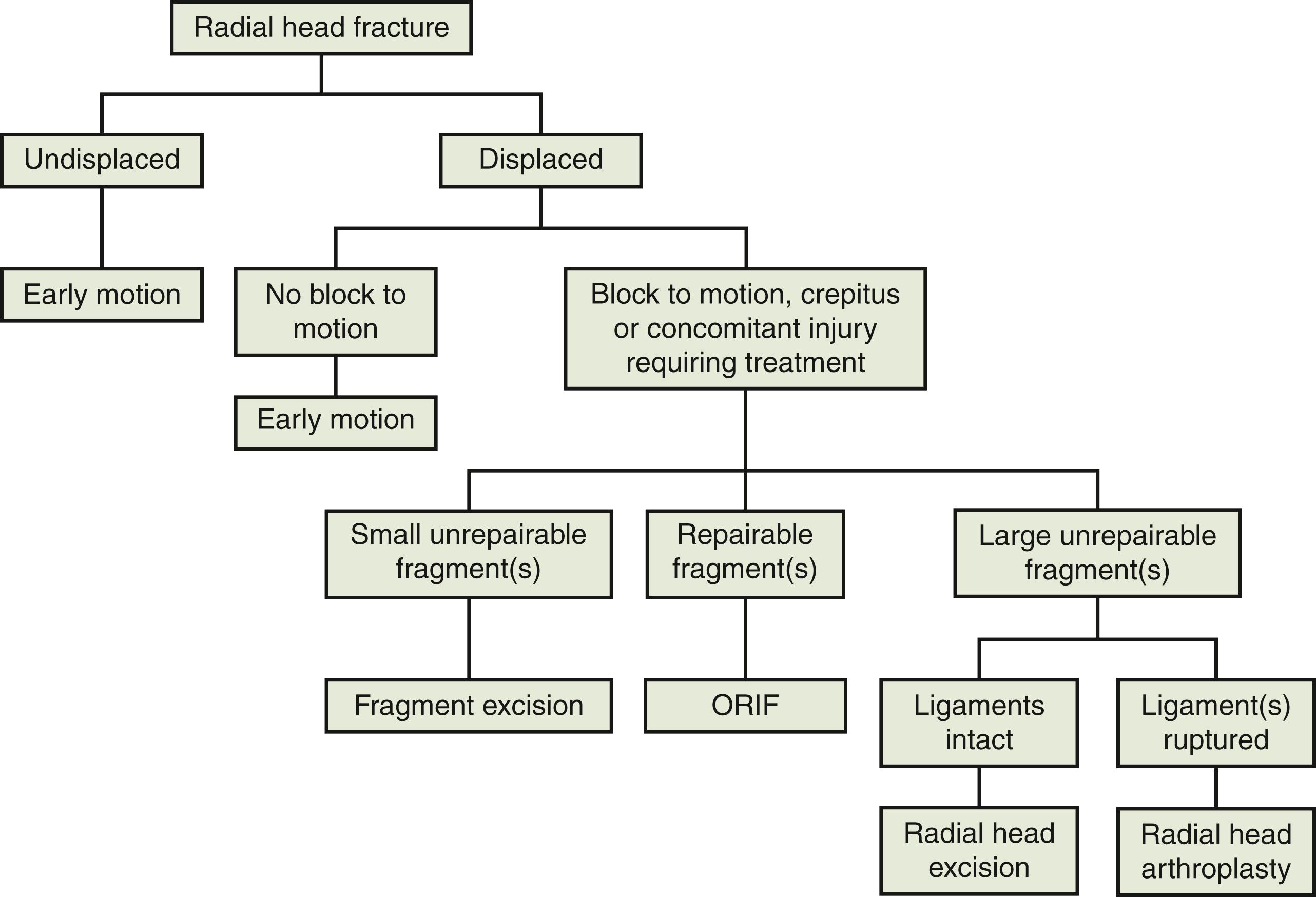
Nondisplaced or isolated displaced fractures of the radial head and neck, which do not cause a block to elbow or forearm motion, are offered nonoperative management. Depressed fractures generally do not impede forearm rotation, whereas extruded fragments do, often by virtue of their impingement with the proximal radioulnar joint and annular ligament. Whereas some authors have recommended cast immobilization, , most studies have supported the concept of early motion. , Aspiration of the elbow hemarthrosis and injection of local anesthetic, as previously described, should be considered only if there is enough pain to prevent evaluation of forearm rotation. , In a prospective randomized clinical trial, aspiration and injection of anesthetic in the absence of a mechanical block to motion demonstrated no effect on final outcome.
Active motion should be initiated within 1 week, owing to the frequent development of elbow stiffness with longer periods of immobilization. A long arm splint, collar and cuff, or sling is used for comfort between periods of active motion and should be discontinued by 4 weeks ( Fig. 19.11 ). The use of a static progressive extension splint should be considered at night if elbow extension does not progressively improve in the first 4 to 6 weeks following the injury. Although subsequent displacement is uncommon, careful clinical and radiographic follow-up is required. Late displacement may be more common with fractures involving more than one-third of the radial head.
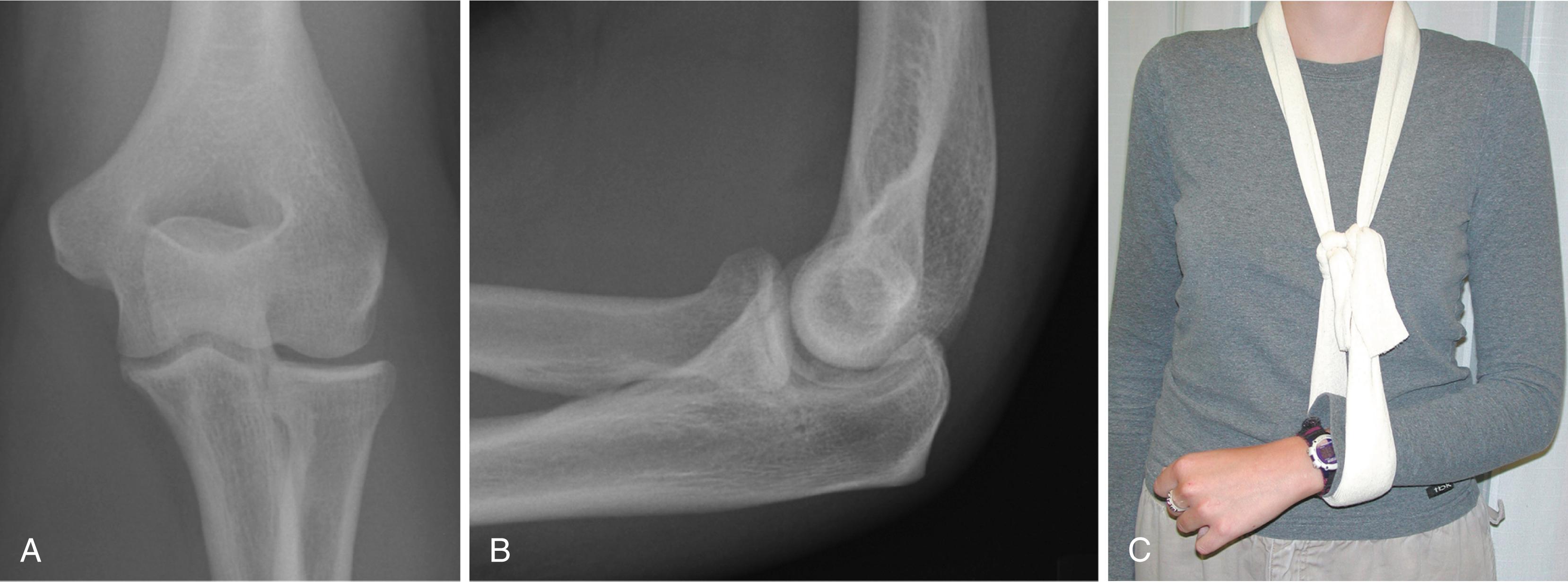
Patients with isolated noncomminuted displaced fractures of the radial head with a mechanical block to forearm or elbow motion and those with concomitant injuries requiring surgical management (e.g., coronoid, olecranon, or capitellum fractures or complex elbow instability) are managed with ORIF if stable fracture repair is possible. Based on a lack of scientific evidence to direct management, the option of ORIF is explained to healthy active patients if they have an isolated noncomminuted fracture of the radial head that is displaced more than 2 mm and involves greater than one-third of the diameter without a mechanical block to rotation. I also explain that many patients with these fractures can do well with nonsurgical treatment and that we are not sure what the optimal management is. , Furthermore, a good outcome following ORIF of displaced radial head fractures is not assured and complications are frequent. , Mason suggested that displaced fractures greater than one-fourth of the diameter of the radial head should be treated by radial head excision.
Geel and colleagues recommended ORIF of displaced (>2 mm) fractures involving more than one-fourth of the radial head. Radin and Riseborough suggested that displaced fractures greater than one-third of the radial head should be managed operatively. Miller and others reported that fragment size had no effect on the outcome of type II fractures. Ultimately, it is best to try to help the patient make an informed decision between operative and nonoperative management; when the optimal treatment is unclear, I favor nonoperative management as the reported outcomes are good and there are satisfactory salvage options for patients whose outcome is unsatisfactory.
The ability to reliably repair the radial head often can only be determined intraoperatively. ORIF of multifragmented radial head fractures can be successful if stable internal fixation is achieved so that early motion can be initiated. , , , , , , , One study reported a high incidence of complications following ORIF of greater than three fragments, suggesting an alternative treatment method should be considered for more comminuted fractures. Failure to achieve a congruous reduction and rigid fixation owing to comminution or osteoporosis should prompt the surgeon to intraoperatively consider excision of the radial head or replacement. Tenuous fixation in the setting of associated ligamentous injuries should be avoided because minimal residual instability following ligament repair will likely lead to fixation failure. , , Failed surgical reconstruction usually leads to articular injury of the capitellum and the radial notch of the ulna. Stiffness and pain frequently require further surgery, often with less than satisfactory results. The outcome for patients with failed internal fixation is typically not as successful as those managed initially with excision of the radial head or replacement, suggesting that intraoperative decision making is critical to optimize treatment result. ,
Reduction and internal fixation of displaced fractures of the radial head using arthroscopy are difficult owing to the inability to distract the radiocapitellar joint to properly evaluate the articular reduction. Furthermore, bleeding often compromises the view such that a 3- to 5-day delay before surgery is recommended. Standard elbow arthroscopic techniques and equipment are employed; however, a 70-degree arthroscope may be helpful to better visualize the joint’s surface. The efficacy and indications for arthroscopic reduction of fractures of the radial head are evolving. Open surgical approaches remain the current standard of care.
Although many authors suggest a Kocher approach, some have employed a lateral epicondyle osteotomy. However, splitting the common extensor tendon near the midline of the radiocapitellar axis allows better access to the anterior radial head where most marginal fractures occur and avoids injuring the lateral ulnar collateral ligament, which is at risk with the Kocher approach. ,
Fixation is performed using bioabsorbable pins, headless screws, 1.5- to 2.0-mm screws, or 2.3- to 3.0-mm cannulated screws. Plate options include standard small-fixation systems or purpose-designed proximal radius precontoured locking systems. Smooth Kirschner wires are useful to reduce fragments and provide provisional fixation; however, they should not be employed for definitive fixation because of the tendency for these to migrate during the postoperative period. Screws should be countersunk to prevent impingement with the radial notch and annular ligament even if placed on the nonarticular margin.
The use of crossed cannulated 2.5- to 3.0-mm screws has been found to be effective for stabilizing the radial head on the neck in the absence of comminution. , Intramedullary fixation also has been reported. Plate fixation is employed for comminuted radial neck fractures in an effort to stabilize the radial head onto the neck and achieve union. Precontoured locking plates are biomechanically superior to the standard T-plates and may yield improved clinical results. , Plates should be placed on the nonarticular portion of the radial head as previously described. If bone grafting is required following elevation of a depressed fragment(s), the lateral epicondyle or proximal ulna is a convenient source. One can use the distal radius metaphysis also. Caution should be exercised when performing ORIF of comminuted displaced fractures of the radial neck in adults because even with optimal reduction and stable fixation, avascular necrosis and nonunion may occur due to the disruption of both the interosseous and periosteal blood supply to the head.
Fragment excision is infrequently indicated with the advent of improved fixation systems with small diameter screws. Cartilage flaps and small displaced fragments (less than one-third of the radial head) that block forearm rotation, due to extrusion into the proximal radioulnar joint or loose fragments that prevent elbow flexion or extension, are treated with open or arthroscopic fragment excision if ORIF is not technically feasible because of small fragment size, comminution, or osteoporosis. , , , Fragments that articulate with the proximal radioulnar joint should not be excised because of interference with forearm rotation.
Early motion with delayed excision of the radial head may be considered for patients with displaced fractures who have no mechanical block to forearm or elbow motion. This approach may be useful in elderly low-demand patients with concomitant injuries to the medial collateral or interosseous ligaments and for patients with a delayed presentation. The radial head can be excised either open or arthroscopically if the patient remains symptomatic after healing of the fracture and any associated ligamentous injury. , , The radial head is excised just distal to the radial notch with careful preservation of the lateral ulnar collateral ligament and repair of the annular ligament if done through an arthrotomy. To ensure replacement, arthroplasty is not required; intraoperative valgus and a varus stress fluoroscopy should be obtained after radial head excision to ensure competency of the medial and lateral collateral ligaments of the elbow. To evaluate for an interosseous ligament tear, perform axial loading with radial deviation of the wrist and forearm distraction with ulnar deviation of the wrist while monitoring ulnar variance with fluoroscopy ( Fig. 19.12 ). Using a serrated reduction clamp on the radial neck and applying a proximal-distal pull may be a more sensitive technique to identify axial instability after radial head excision.
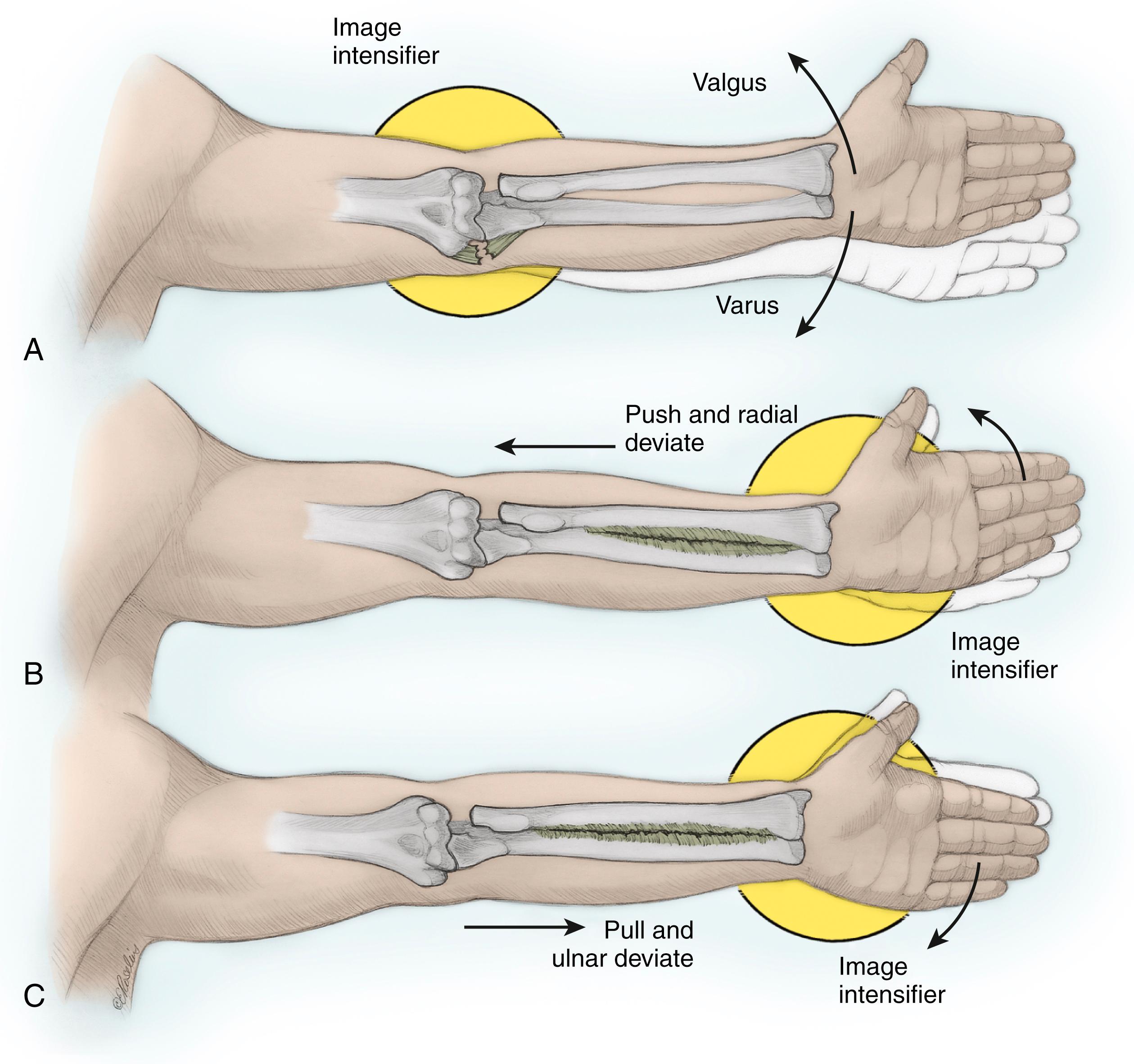
Prior to the development of more reliable methods of internal fixation and durable prostheses, displaced fractures of the radial head, both simple and comminuted, were commonly treated by open excision of the radial head. , , , , , , , , , , , Although less frequently performed currently, excision of the radial head is preferable to an unstable or incongruous ORIF. Should radial head reconstruction be technically impossible, associated soft tissue injuries and concomitant fractures should be evaluated because acute radial head excision is contraindicated in the setting of concomitant disruption of the medial or lateral collateral ligaments, interosseous membrane, or elbow dislocation. ,
The radial head can be excised through either an arthrotomy or an arthroscopy, , as previously noted. If the intraoperative stress tests for varus, valgus, and axial instability described are negative, there was no associated elbow dislocation and no clinical suspicion of a ligamentous injury, acute radial head excision without implant replacement may be considered. Given the high incidence of associated ligamentous injuries with comminuted radial head fractures, and the difficulty in diagnosing these associated conditions, the author currently does not perform this procedure unless there is gross wound contamination, an unreconstructible extension of the fracture into the radial neck, or a concomitant severe articular injury to the capitellum that precludes the use of a metallic radial head arthroplasty. Careful preservation of the lateral ulnar collateral ligament and repair of the annular ligament should be performed if the radial head is excised open. The timing of radial head excision is controversial, as a result of concerns regarding the potential development of heterotopic ossification, with some authors recommending early excision (<24 h) , , , and others excision within 10 days. , The presence of an associated dislocation and a closed head injury appear to be the risk factors most associated with the development of heterotopic ossification following elbow surgery. , ,
Replacement arthroplasty is indicated for displaced comminuted fractures of the radial head and neck when an anatomic reduction and stable internal fixation is not achievable and there are, or are likely to be, associated soft tissue or bony injuries. These include soft tissue injuries to the medial or lateral collateral ligaments, the interosseous membrane, and/or triangular fibrocartilage and bony injuries of the coronoid or olecranon.
Silicone implants have been employed in the past. , However, they are no longer recommended as they are biomechanically inferior to metal and have a high incidence of fracture and fragmentation, sometimes with the development of silicone synovitis. , , Recent clinical series of studies using metallic implants noted good results relative to earlier reports using silicone. , , , , , , , Earlier metallic radial head implants employed a monoblock design making size-matching suboptimal and implant insertion often difficult, owing to the need to subluxate the elbow to allow for insertion of these devices. Modular metallic radial head prostheses, with separate heads and stems, are now employed, allowing improved sizing options and easier implantation. The surgical techniques used to place currently available implants vary somewhat; however, most employ a Kocher or preferably a common extensor tendon-splitting approach and divide the radial collateral and annular ligaments while preserving the integrity of the lateral ulnar collateral ligament when it is intact. Available prostheses include smooth stem spacer implants, press-fit, or ingrowth stems, as well as cemented devices. Metallic and pyrolytic carbon articulations are also available. Most implants have a fixed head-stem but bipolar devices are available too. Although most designs are axisymmetric, there is one currently available system with a more elliptical articulation. There are no randomized trials comparing the clinical outcomes of the various radial head implant designs. Some radial head implant designs have proven problematic and resulted in their withdrawal from the market due to a high incidence of complications.
Even with intact ligaments, biomechanical studies have demonstrated an alteration in the kinematics and stability of the elbow following radial head excision. , These in vitro studies have also shown that metallic radial head replacement restores the kinematics and stability of the elbow similar to that with a native radial head. , Furthermore, the clinical results of radial head excision at long-term follow-up have been variable, , , , , , , while the medium-term results of metallic radial head arthroplasty have been encouraging with most currently available implant designs. , , , , , , , , On the basis of these biomechanical and clinical studies, and the known high incidence of concomitant ligamentous injuries with comminuted fractures, this author routinely replaces the radial head in the setting of an unreconstructible fracture.
Place the patient in the supine position on the operating table and use a rolled towel or sandbag beneath the ipsilateral scapula to assist in positioning the arm across the chest. Alternatively, an arm table can be used with the surgeon sitting. Use a lateral decubitus position in the setting of a concomitant proximal ulna or olecranon requiring fixation. Administer prophylactic intravenous antibiotics. General or regional anesthesia should be employed. I perform a fluoroscopic evaluation of the elbow prior to prepping and draping to look for associated ligament injuries and instability of the elbow and/or forearm.
Use a sterile tourniquet. While many surgeons use a lateral incision, I prefer a midline posterior elbow incision just lateral to the tip of the olecranon and elevate a full-thickness lateral flap on the deep fascia ( Fig. 19.13 ). This extensile incision decreases the risk of cutaneous nerve injury and provides access to the radial head, coronoid, medial, and lateral collateral ligaments if needed for the management of more complex injuries. , A posterior incision is also more cosmetically acceptable than standard laterally placed incisions. Maintain the forearm in pronation to move the posterior interosseous nerve more distal and anterior during the surgical approach.
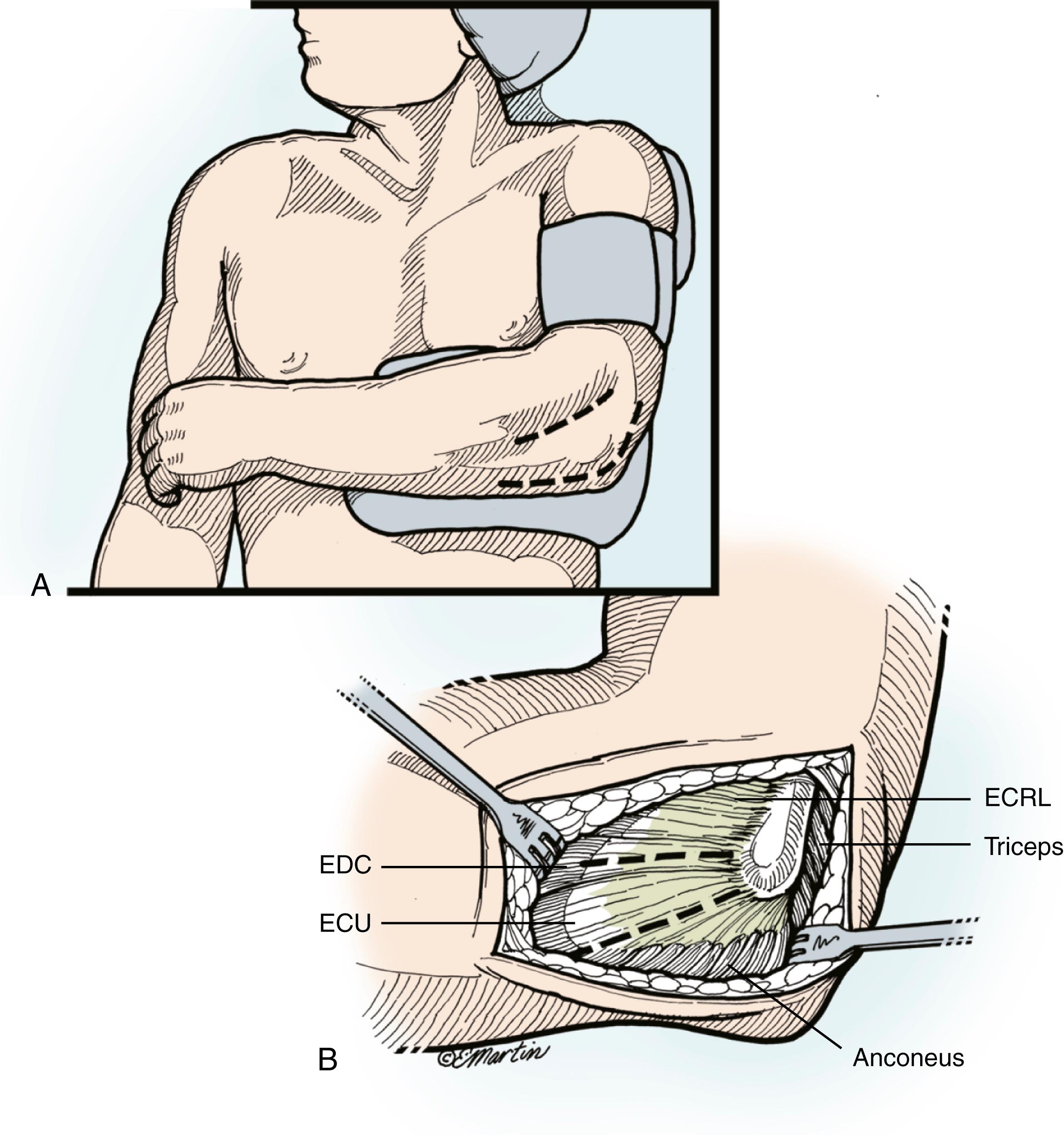
In patients with known injuries to the lateral collateral ligament, such as following a dislocation or as identified using fluoroscopy, my preference is a Kocher approach to access the radial head and to facilitate ligament repair. Identify the fascial interval between the anconeus and extensor carpi ulnaris by noting the diverging direction of the muscle fibers and small vascular perforators that exit at this interval ( Fig. 19.14 ). Humeral avulsion of the lateral collateral ligament and common extensor muscles from the lateral epicondyle are commonly noted in patients following fractures of the radial head; this is a consistent finding in patients with a concomitant elbow dislocation, simplifying surgical exposure of the radial head. In these circumstances the radial head is easily visualized after opening the fascia of the Kocher interval, at which point a bald lateral epicondyle is evident and the deep dissection exploits this disruption to approach the radial head.
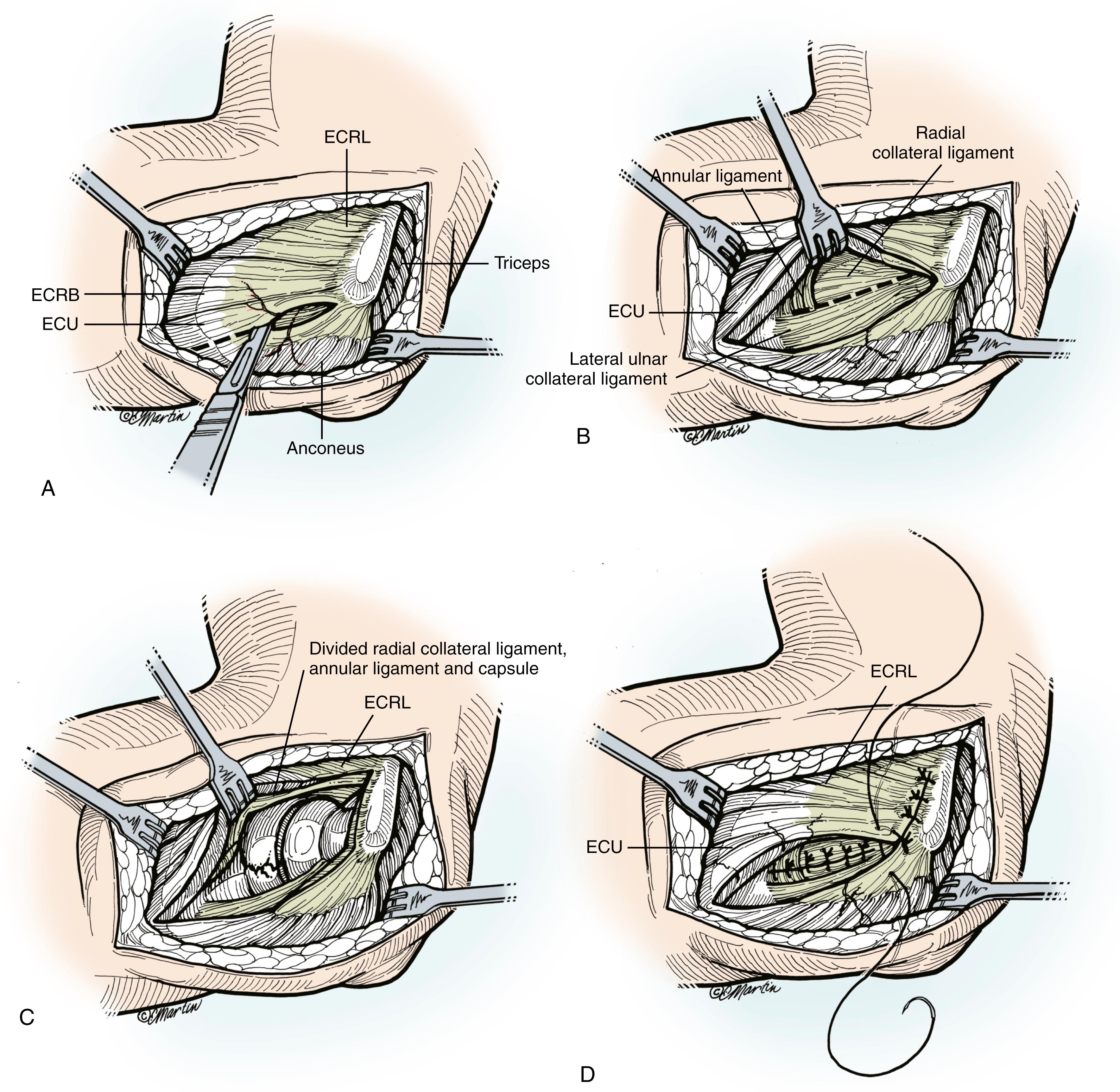
If the lateral ligament is found to be intact, elevate the extensor carpi ulnaris anteriorly off the underlying lateral ulnar collateral ligament and incise the radial collateral and annular ligaments longitudinally at the midaxis of the radial head. Elevate the humeral origin of the radial collateral ligament and the overlying extensor muscles anteriorly off the lateral epicondyle to better expose the anterior half of the radial head if required. Avoid posterior dissection in the setting of intact ligaments to preserve the integrity of the lateral ulnar collateral ligament and thereby maintain the varus and posterolateral rotatory stability of the elbow. , Release the posterior component of the lateral collateral ligament if further exposure is needed, and carefully repair the ligament at the end of the procedure. Elevate the supinator from posterior to anterior, and identify the posterior interosseous nerve if dissection is required distal to the radial tuberosity to allow fixation of a proximal radius fracture.
For patients with an intact lateral collateral ligament, I prefer a common extensor tendon-splitting approach ( Fig. 19.15 ). Divide the common extensor tendon and the underlying radial collateral and annular ligaments longitudinally at the midaspect of the radial head. Keep the forearm in pronation and avoid dissection distal to the radial tuberosity to protect the posterior interosseous nerve. Elevate the radial collateral ligament and common extensor muscles anteriorly off the lateral epicondyle if needed to further improve exposure. Division of the posterior component of the lateral collateral ligament can be considered if further exposure of the radial head is needed, but a meticulous ligament repair is required. Similarly, extension distal to the proximal aspect of the radial tuberosity requires identification of the posterior interosseous nerve.
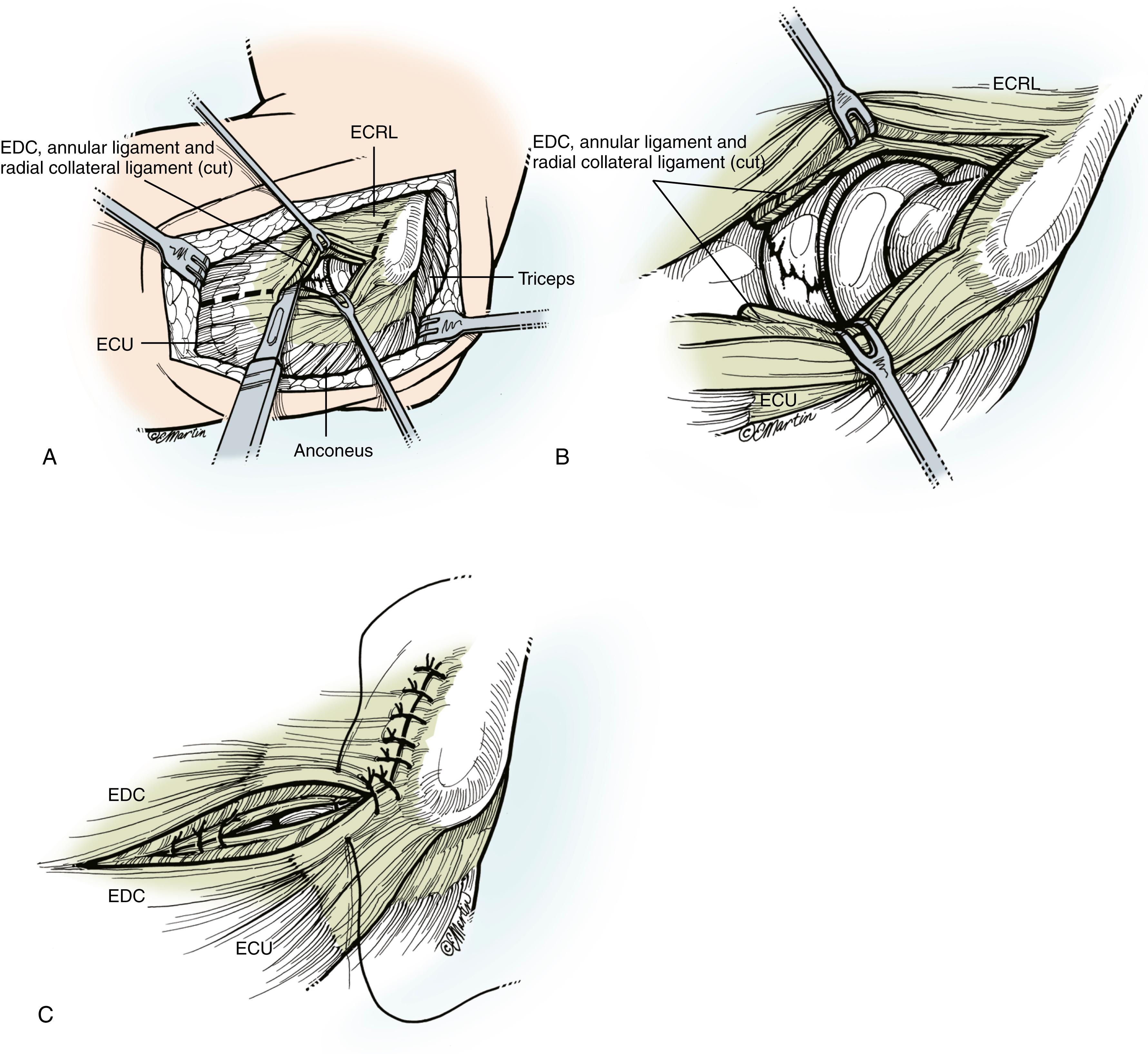
If a decision can be made preoperatively that a small, displaced fragment(s) cannot be reliably fixed with ORIF, I use arthroscopy to remove the fragments. Localization of the fragment(s) is superior to what can be achieved with a limited arthrotomy, and the morbidity is low in surgeons with experience with elbow arthroscopy. Standard arthroscopic techniques, as described in Chapter 26 , are employed. Surgery is performed 3 to 5 days after injury to avoid problematic bleeding that may occur with early surgery.
The decision that a fracture cannot be reliably fixed is most commonly made intraoperatively during an attempted open reduction ( Fig. 19.16 ). I use an image intensifier, a pituitary rongeur, and copious irrigation to extract small, displaced, unreconstructible fragments. , A small dental pick can also be helpful to manipulate small fragments. Avoid inadvertent removal of a coronoid fragment by noting its triangular shape and its attachment to the anterior capsule. Evaluate the remaining radial head to ensure that the deficient portion does not articulate with the radial notch in any position of forearm rotation. Ensure congruent tracking of the residual radial head with the capitellum before repairing the annular, radial, and lateral ulnar collateral ligaments as described later. Because removal of the anterior rim of the radial head in the setting of a lateral collateral ligament injury may contribute to residual posterolateral rotatory instability, , careful lateral collateral ligament repair and rehabilitation with the forearm in pronation are essential to achieve a successful outcome.
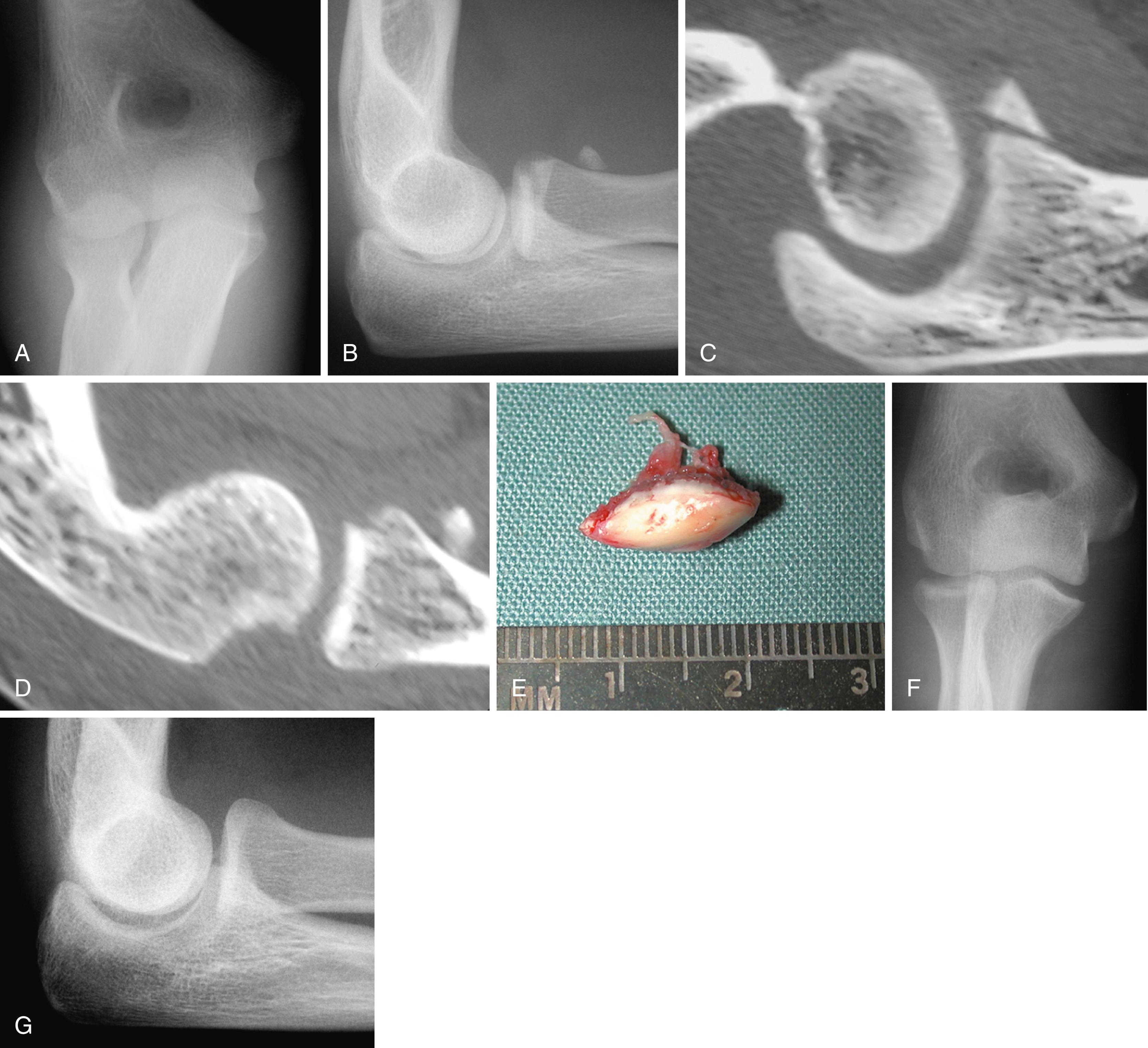
In my experience, arthroscopic reduction and internal fixation of fractures of the radial head has not been rewarding because of the difficulty of obtaining a good view of the articular dish, which is obscured by the curvature of the capitellum. The inability to distract the radiocapitellar joint makes visualization of the reduction much more difficult than fixation of simple capitellum fractures or selected fractures at the wrist or knee. Further complicating arthroscopic reduction and internal fixation is the small working space in which the fragments can be manipulated and limited safe-approach angles for fixation devices.
Displaced unreconstructible fragment(s) less than one-third radial head diameter that is blocking forearm or elbow motion or is interposed within the articulation.
Become a Clinical Tree membership for Full access and enjoy Unlimited articles
If you are a member. Log in here